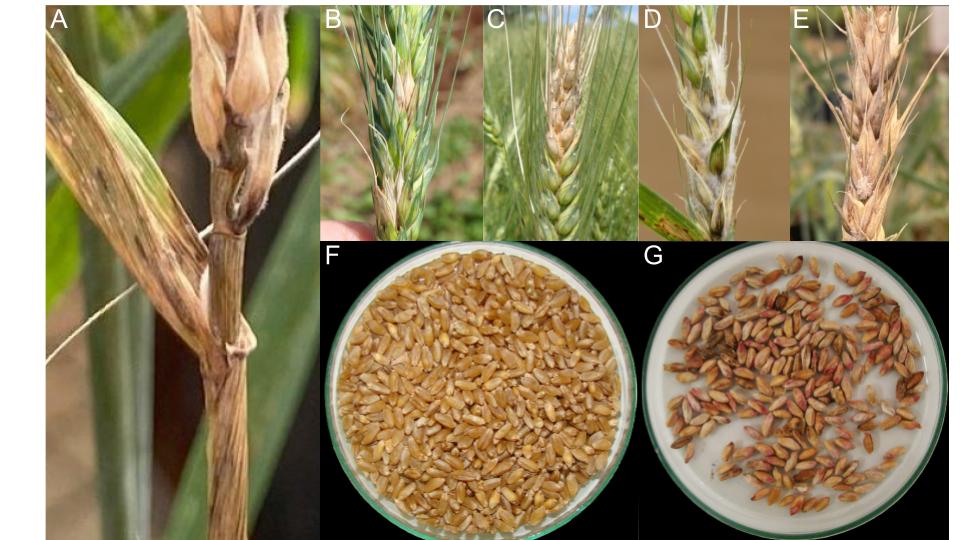Fusarium Head Blight in Wheat
etiology, symptoms, mycotoxin, and management
Keywords:
Fusarium graminearum, fungicide, resistance cultivars, deoxynivalenol (DON)Abstract
Fusarium head blight, a disease primarily caused by the fungus Fusarium graminearum, is one of the most significant phytosanitary challenges for wheat cultivation in southern Brazil. This disease severely affects both yield and grain quality, primarily due to the production of mycotoxins, particularly deoxynivalenol (DON), a compound of high toxicity to both humans and animals. The incidence of Fusarium head blight (FHB) tends to increase in years marked by the occurrence of the El Niño climatic phenomenon, especially during the flowering stage of the crop, when environmental conditions are most conducive to infection. Effective management of FHB requires the implementation of an integrated approach that includes preventive measures, appropriate cultural practices, the use of cultivars with higher genetic resistance, as well as continuous monitoring of crop fields and meteorological conditions. Given the high toxicity of the mycotoxins associated with the disease, along with the inherent challenges of its control, the ongoing improvement of integrated management strategies is imperative, alongside the strengthening and strict enforcement of current sanitary regulations.Metrics
Publication Facts
Reviewer profiles N/A
Author statements
- Academic society
- Epagri - Revista Agropecuária Catarinense
- Publisher
- Empresa de Pesquisa Agropecuária e Extensão Rural de Santa Catarina - Epagri
References
CONAB. Série histórica das safras: Trigo. 2024a. Disponível em: https://www.conab.gov.br/info-agro/safras/serie-historica-das-safras/itemlist/category/913-trigo. Acesso em: 29 nov. 2024.
CONAB. Trigo: análise mensal – janeiro de 2024. 2024b. Companhia Nacional de Abastecimento (CONAB), 2024. Disponível em: https://www.conab.gov.br/info-agro/analises-do-mercado-agropecuario-e-extrativista/analises-do-mercado/historico-mensal-de-trigo/item/23503-trigo-analise-mensal-janeiro-2024. Acesso em: 29 nov. 2024.
JAKUBCZYK, K.; MELKIS, K.; DALEWSKI, B.; JANDA-MILCZAREK, K. Assessment of antioxidant properties and mycotoxin profile of commercial spirulina supplements. Food Bioscience, v. 62, p. 105461, dez. 2024. Elsevier BV. http://dx.doi.org/10.1016/j.fbio.2024.105461.
KHEIRI, A.; JORF, S. A. M.; MALIHIPOUR, A. Infection process and wheat response to Fusarium head blight caused by Fusarium graminearum. European Journal of Plant Pathology, v. 153, p. 489-502, 2019. Doi: 10.1007/s10658-018-1576-7.
LAZAROTTO, M. Identificação e caracterização de Fusarium spp. e Pestalotiopsis spp. associados a Carya illinoinensis no Rio Grande do Sul. 2013. 219 f. Tese (Doutorado em Engenharia Florestal) – Universidade Federal de Santa Maria, Santa Maria, RS.
LIMA, M. I. P. M.. Giberela ou Brusone? Orientações para a identificação correta dessas enfermidades em trigo e em cevada. Embrapa, 2004. Disponível em: https://www.cnpt.embrapa.br/biblio/do/p_do40.pdf.
NICOLLI, C. P. Reprodução, patogenicidade e potencial toxigênico de Fusarium graminearum, F. meridionale e F. cortaderiae. 2018. 129 f. Dissertação (Mestrado em Fitopatologia) – Universidade Federal do Rio Grande do Sul, Porto Alegre, 2018.
OBSERVATÓRIO AGRO SC. Painéis de produção agropecuária. Governo do Estado de Santa Catarina, 2024. Disponível em: https://www.observatorioagro.sc.gov.br/areas-tematicas/producao-agropecuaria/paineis. Acesso em: 9 dez. 2024.
REIS, E. M.; CASA, R. T.; FORCELINI, C. A. Doenças do trigo. In: FILHO, A. B.; KIMATI, H.; AMORIN, L. (Ed.). Manual de Fitopatologia: Doenças de plantas cultivadas. São Paulo, Agronômica Ceres Ltda: 1997. p. 725 a 735.
ZADOKS, J. C.; CHANG, T. T.; KONZAK, C. F. A decimal code for the growth stages of cereals. Weed Research, Oxford, v. 14, p. 415 a 421, 1974.

Downloads
Published
How to Cite
Issue
Section
License
Copyright (c) 2025 Yasmin Branger Figueiredo, Vanessa Fernandes Soares, Cristiano Nunes Nesi, João Américo Wordell Filho

This work is licensed under a Creative Commons Attribution 4.0 International License.




